| Author |
Message |
|
Walter Stockwell
|
 Posted: Wed 22 Nov, 2006 2:47 am Post subject: Posted: Wed 22 Nov, 2006 2:47 am Post subject: |
 |
|
| Nathan Robinson wrote: | Regarding of the dirk and targe together, I highly recommend reading "The dirk and targe: their use together" by Colin R. Rolland. it was published in The Third Park Lane Arms Fair Catalog.
Attached is one depiction of how they may have been held together.
It is asked why a person might hold and use the dirk in this fashion. It is suggested that the commonly held belief that the dirk was used offensively is quite erroneous as it is unlikely that any advantage could be made by using the slow and clumsy offensive back-handed slashes that this position would allow. After all, the hand is weighed down by the heft of the targe and the hand's movement is greatly effected by its being strapped into the shield.
|
Thank you for this interesting excerpt and picture.
| Quote: |
Instead two suggestions are presented: the first is that it would provide easy access to the dirk should the wielder's sword become unavailable for any reason. If this were to happen, the dirk would be immediately available without delay. The second suggestion is that, by holding it point downward, a defensive opportunity has presented itself.
|
I do not find the first reason that convincing. If you lost your sword in battle, you would need to reach for your other arm to take the dirk. This other arm might be busy fending off an attack. You would be exposing yourself to injury while trying to transfer the dirk between hands. Also, this would be no quicker than simply taking the dirk out of a scabbard on your belt. I also think you are less likely to lose your dirk if it is sheathed properly than if you are carrying it and using it in your parrying hand. By carrying the dirk, you also risk injuring yourself with it (for example, if you stumble and fall on it.) I don't think a warrior would hold the dirk in the left hand unless he actually had active use for it in that hand.
| Quote: |
Because of the position and size of the targe, the upper body is quite well protected by it, but the lower torso and legs are quite exposed to a cut. The article goes on to suggest that such attacks can be parried by a lateral and downward movement of the targe so as to lock the opponent's weapon between the dirk blade and the targe's edge, "thus unbalancing the adversary and exposing him to a swift courterattack." |
I suppose this might apply to single combat, but I wonder how it applies to battlefield tactics.
Does this apply to the highland charge? Did the attacker have time for careful blade locks? Or might the targe and dirk be used to smash into the enemy line? When you are using your motion and body mass as the attack, you don't need to have a quick hand to make an attack with the targe and dirk.
In addition, could the dirk and spike on the targe be there for intimidation? Much of the point of the charge was to break the opposing formation, and intimidation and shock probably was an important factor in this. If you have a line of scots charging you with pointy sharps in both hands, you're going to be kept pretty busy.
I guess the last thing to remember is that not every targe had a spike, and not everyone carried a targe or targe and dirk. As Henrik pointed out, using either or both and how was probably a very personal choice.
Walter
www.stockwellknives.com
|
|
   |
 |
Joe Lindsay
Industry Professional

Location: Scotland Joined: 07 Nov 2006
Posts: 8
|
 Posted: Wed 22 Nov, 2006 3:30 am Post subject: Posted: Wed 22 Nov, 2006 3:30 am Post subject: |
 |
|
Couple of things I'd like to add.
Having tested it, it takes about half a second to transfer the dirk from the left hand to the right. This is much quicker than holding the dirk sheath in one hand and pulling the dirk out with the other, while worrying about being killed.
If you put yourself in the position that you are fighting for your life - not kidding - you would want every advantage you could get. They wernay daft !
As regards the spike. I reckon it could have in some cases been a bit of a liability. If it got stuck in another targe, or in another's body, then it would render the targe unuseable. Also, if an enemy was able to grab hold of it, he could pull you all over the place with the "handle".
From my research, I would say that about a quarter of the old targes had spikes.
I believe that there is only one genuine authentic original spike surviving, and it is with the Stewart targe which is still owned by the descendants of the original owner.
This spike is about 12" long, very thin, and of square section. ( see photos below ).
Personally , for commercial reasons I make my spikes round section at present. There is nothing to suggest that all spikes were square section, and I'm quite sure they were able to make round ones in Jacobite days.
I've also shown below a photo of a targe in Kelvingrove Museum which came from the collection of the Marquis of Graham, showing how the spike was probably fixed under the boss. It looks like a "puddle" of lead nailed through and "clenched " over on the back. This has a hole in the middle into which the threaded end of the spike would have been screwed.
From my experience with the "Stewart" targe (belonged to Major James Stewart, who fought in the civil wars of the 1640s), I would say that the spikes were not particularly well secured, and would probably have become inneffective after a blow or two from a sword.
Joe Lindsay Targemaker
 Attachment: 32.21 KB Attachment: 32.21 KB
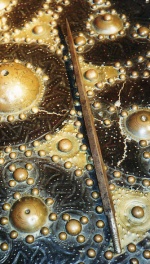
Stewart spike
 Attachment: 40.32 KB Attachment: 40.32 KB

Stewart spike length
 Attachment: 55.65 KB Attachment: 55.65 KB
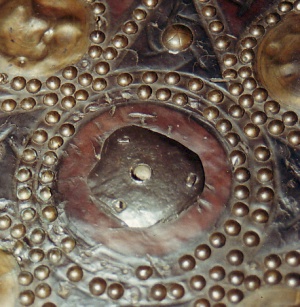
Graham spike holder ?
Nothing is ever what it seems - old john
|
|
   |
 |
|
Larry Davis
Location: canada Joined: 05 Jul 2004
Posts: 17
|
 Posted: Wed 22 Nov, 2006 4:25 pm Post subject: Spike attachments Posted: Wed 22 Nov, 2006 4:25 pm Post subject: Spike attachments |
 |
|
The methods of attachment that I have seen were a forged iron, threaded 'nut' that had two projecting arms or prongs.
These were bent over much like a staple then pushed through the wood and bent over in different directions on the other side.
You can see one of this type on the x-ray below.
 Attachment: 12.46 KB Attachment: 12.46 KB
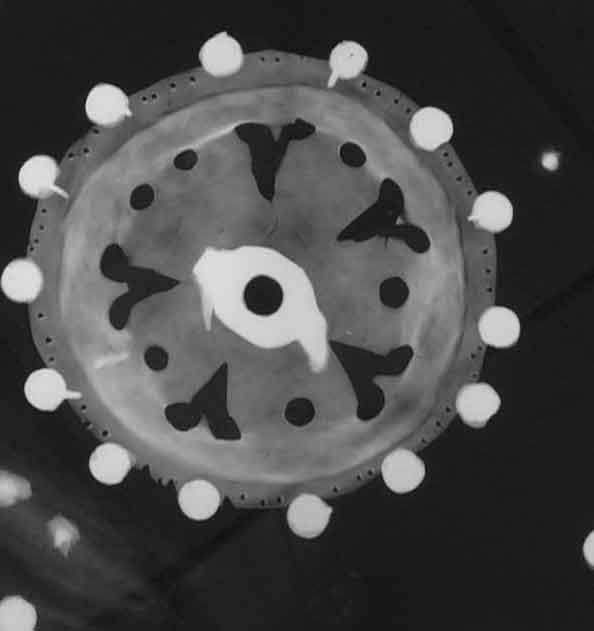
|
|
 |
 |
|
Larry Davis
Location: canada Joined: 05 Jul 2004
Posts: 17
|
 Posted: Wed 22 Nov, 2006 4:47 pm Post subject: Spike attachments Posted: Wed 22 Nov, 2006 4:47 pm Post subject: Spike attachments |
 |
|
Here is a picture of a larger 'nut' type.
And a shot of the prongs bent over on the reverse side of a different targe.
Some bosses had an internal wooden plug that would also give support to the spike.
Some where or other I have seen a targe with a cut down sword blade as the spike. It utilized the threaded tang as the means of affixing it to the nut.
It might have been at the Marischal museum in the University of Aberdeen, perhaps Joe could check it out, you are allot closer than I am at this point .
Joe, any chance of getting together and comparing notes next time I'm in Scotland?
Cheers,
Larry.
 Attachment: 7.39 KB Attachment: 7.39 KB
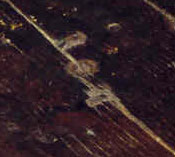
|
|
 |
 |
|
Larry Davis
Location: canada Joined: 05 Jul 2004
Posts: 17
|
 Posted: Wed 22 Nov, 2006 4:50 pm Post subject: Posted: Wed 22 Nov, 2006 4:50 pm Post subject: |
 |
|
The picture of the nut type. I guess it didn't go through on the last post.
On this one you can see that it is held on to the targe by a nail at each of the corners of the nut plate.
 Attachment: 10.25 KB Attachment: 10.25 KB
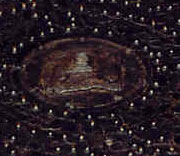
 Attachment: 10.25 KB Attachment: 10.25 KB
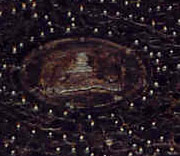
|
|
 |
 |
Thomas McDonald
myArmoury Alumni


|
 Posted: Thu 23 Nov, 2006 4:24 am Post subject: Posted: Thu 23 Nov, 2006 4:24 am Post subject: |
 |
|
Thanks for those pics, & info, on the Stewart targaids spike, Joe !
Mac
Stewarts of Ardvorlich
Fig. 4:9 'Culloden The Swords & The Sorrows' -- Scottish Highland Targe -- Decorated with a series of brass bosses over tooled cowhide. The large engraved brass central boss has a threaded metal spike which screws into the centre of the boss. The back of the targe is covered in deerskin; the arm-strap is missing, a leather scabbard for the spike and hand-grip survive. c. 1740. 19" diameter. * This is the only recorded targe known to have its original iron spike. Lender: Private collection.
 Attachment: 111.64 KB Attachment: 111.64 KB
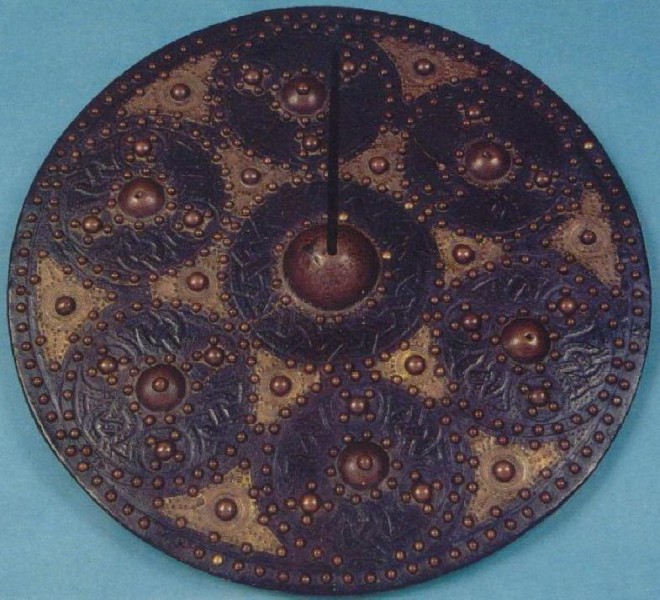
 Attachment: 73.64 KB Attachment: 73.64 KB
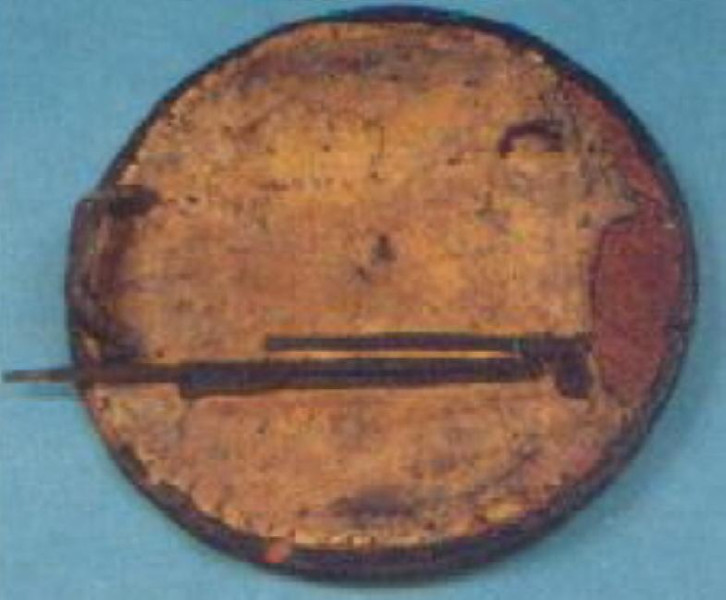
'Gott Bewahr Die Oprechte Schotten'
XX ANDRIA XX FARARA XX
Mac's PictureTrail
|
|
   |
 |
Joe Lindsay
Industry Professional

Location: Scotland Joined: 07 Nov 2006
Posts: 8
|
 Posted: Fri 24 Nov, 2006 4:35 am Post subject: Posted: Fri 24 Nov, 2006 4:35 am Post subject: |
 |
|
Hi Larry.
I reckon that all you guys on the forum have a lot more info on targes than I have, but I would be delighted to meet any of you if you are over.
The "nut" type of spike holder is very interesting. My own method is similar, but a wee bit more modern.
I didn't know about the "John Roy Stuart targe" in the Mariscal museum. Thanks for that. I will try to get over to see it in the next few months. I've looked at it now on the web, and I could be tempted  , but since I've now pretty well committed myself to the Gwynn targe first, I better not over stretch myself. From a commercial point of view, I've got enough of a range, but sometimes I do get a bit bored, and fancy a new challenge. , but since I've now pretty well committed myself to the Gwynn targe first, I better not over stretch myself. From a commercial point of view, I've got enough of a range, but sometimes I do get a bit bored, and fancy a new challenge.
It's years since I did any "research", so I'm quite keen. If business, and Christmas, allows me the time ....
Meanwhile, back to the cave.
Joe Lindsay
Targemaker[/url]
Nothing is ever what it seems - old john
|
|
   |
 |
Patrick Maclaine

|
 Posted: Sat 09 Dec, 2006 2:21 am Post subject: Posted: Sat 09 Dec, 2006 2:21 am Post subject: |
 |
|
Great photos Joe. Tapadh leat. Some lang time ´s passed since the last time we were in touch!.
Mac, I have a couple of articles on the John Stewart of Ardvorlich targaid -including this one- and met different opinions about the date... 1740- 1744... 
I have seen about a dozen of targes featuring this type of configuration for the front!.
Larry, your researches are of an immense assistance to all the craftmen involved in targe-making. Thank you so much for sharing all this important information.
Slàinte, Pat.
Slàinte
Pat Maclaine.
Targe constructor - Fear-cèirde.
Official Representative of the Clan Maclaine of Lochbuie
"Chan ´eil fhios ciod an claidheamh a bhios ´san truaill gus an tàirnear e "
"It is not known what sword is in the sheath till it is drawn"
|
|
   |
 |
Thomas McDonald
myArmoury Alumni


|
 Posted: Sun 10 Dec, 2006 8:35 am Post subject: Posted: Sun 10 Dec, 2006 8:35 am Post subject: |
 |
|
| Patrick Maclaine wrote: | Great photos Joe. Tapadh leat. Some lang time ´s passed since the last time we were in touch!.
Mac, I have a couple of articles on the John Stewart of Ardvorlich targaid -including this one- and met different opinions about the date... 1740- 1744... 
I have seen about a dozen of targes featuring this type of configuration for the front!.
Larry, your researches are of an immense assistance to all the craftmen involved in targe-making. Thank you so much for sharing all this important information. Slàinte, Pat. |
Hi Patrick
I'd be interested to read whatever you have on the Stewart targaid !
Thanks & Cheers, Mac
'Gott Bewahr Die Oprechte Schotten'
XX ANDRIA XX FARARA XX
Mac's PictureTrail
|
|
   |
 |
Patrick Maclaine

|
 Posted: Mon 11 Dec, 2006 11:46 pm Post subject: Posted: Mon 11 Dec, 2006 11:46 pm Post subject: |
 |
|
Hi Mac
I am sure you already have these articles from both "Culloden The Sword and The Sorrows and " The Highland Targe" by Stuart Maxwell"...
I will try to locate a brief note I got ( If I´m not wrong ) from the Museums of Scotland...
As far as I can remember they referred to the targaid´s back " having two staples for an adjustable arm strap - "Non stuffed deer skin lining" and a sheath for a "long and thin iron spike"… dated c. 1744?.
To be sincere, I have hundred notes and I can spend weeks walking in the footsteps of two single lines!
I have spent some two weeks searching for an ancient note from the Acts of the Parliament - dated 1456- on " the tairge othir of ledder or of fyrme burde" ... and I am about to give up this " search for the fitba in the Artic! "... I just met another note from James Logan – not for sure- about " a targe eyther of ledder or of fyrme borde with twa bands on the bak"... 
I will let you know more and better about this old article as soon as I can find the complete note.
All the best.
P.S: Sorry, fitba is the Scot for football.
Slàinte
Pat Maclaine.
Targe constructor - Fear-cèirde.
Official Representative of the Clan Maclaine of Lochbuie
"Chan ´eil fhios ciod an claidheamh a bhios ´san truaill gus an tàirnear e "
"It is not known what sword is in the sheath till it is drawn"
|
|
   |
 |
|
Larry Davis
Location: canada Joined: 05 Jul 2004
Posts: 17
|
 Posted: Tue 12 Dec, 2006 4:21 pm Post subject: Posted: Tue 12 Dec, 2006 4:21 pm Post subject: |
 |
|
Pat,
You are most welcome, If you wish, send me a pm and email address and perhaps we could compare research.
Cheers.
|
|
 |
 |
Patrick Maclaine

|
 Posted: Fri 15 Dec, 2006 10:40 pm Post subject: Targaid... Posted: Fri 15 Dec, 2006 10:40 pm Post subject: Targaid... |
 |
|
I am posting this picture under special request...
Enjoy it Henrik! ... 
Aye, a man of worde...
I made this- destroyed- targaid long ago... the marks are from claidheamh blows, bayonet assaults - see below- etc.
 Attachment: 100.76 KB Attachment: 100.76 KB
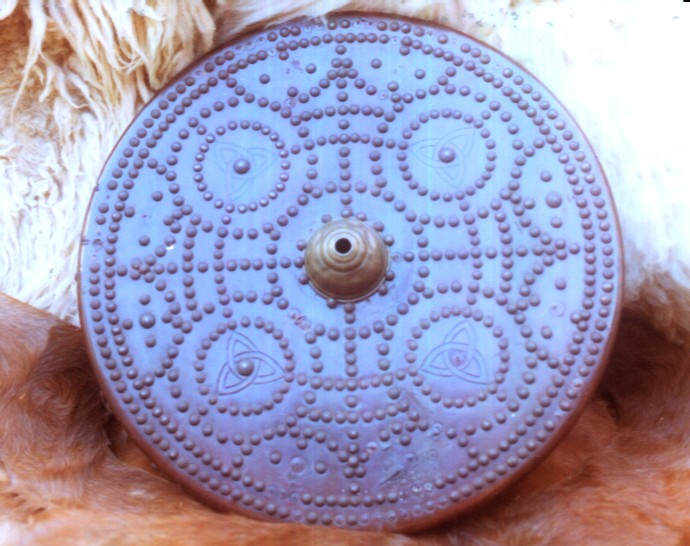
Slàinte
Pat Maclaine.
Targe constructor - Fear-cèirde.
Official Representative of the Clan Maclaine of Lochbuie
"Chan ´eil fhios ciod an claidheamh a bhios ´san truaill gus an tàirnear e "
"It is not known what sword is in the sheath till it is drawn"
|
|
   |
 |
Henrik Bjoern Boegh

Location: Agder, Norway Joined: 03 Mar 2004
Posts: 386
|
 Posted: Sat 16 Dec, 2006 10:59 am Post subject: Posted: Sat 16 Dec, 2006 10:59 am Post subject: |
 |
|
Oooh! That looks great! The beating gives a bit of extra character, doesn't it?
Thanks for sharing, Pat.
Cheers,
Henrik
Constant and true.
|
|
  |
 |
Patrick Maclaine

|
 Posted: Sat 16 Dec, 2006 4:32 pm Post subject: Henrik Posted: Sat 16 Dec, 2006 4:32 pm Post subject: Henrik |
 |
|
You are always ceud ḿle fàilte Henrik!
Cheers.
Slàinte
Pat Maclaine.
Targe constructor - Fear-cèirde.
Official Representative of the Clan Maclaine of Lochbuie
"Chan ´eil fhios ciod an claidheamh a bhios ´san truaill gus an tàirnear e "
"It is not known what sword is in the sheath till it is drawn"
|
|
   |
 |
Chris Goerner

|
 Posted: Fri 29 Dec, 2006 7:11 am Post subject: Posted: Fri 29 Dec, 2006 7:11 am Post subject: |
 |
|
| Joe Lindsay wrote: | | Walter Stockwell wrote: |
To follow on this... why hold a dirk in the targe hand if one is unable to use it (either because the targe is too heavy, or no reach.) If you can hurt someone with a dirk in your hand, you can probably hurt them with a spike on your targe. |
I've thought about this a lot, and now think that the simple reason for holding the dirk in the targe hand is in case you lose, or break your sword. The dirk is immediately available.
If I was fighting for my life, that's what I would do.
Certainly, with my targes, it is easy to hold both in one hand ( but definitely not by putting your hand right through the handle !! - it would get chopped off !! - David Morier has a lot to answer for )
Joe Lindsay (forum virgin ) |
I recently redid the strapping on a reproduction targe. Looking at photos of originals and better reproductions, it appears to me that the hand strap is really more of a handle, being somewhat round in cross section. Having copied that style for my targe, I now find it difficult to hold my dirk in the targe hand. I would be interested in hearing from others as to whether they have experienced similar issues, or if their targes use more of a strap for the hand than a handle.
Thanks to all who have contributed to this thread. Great information and photos!
Chris
Sic Semper Tyranus
|
|
  |
 |
Joe Lindsay
Industry Professional

Location: Scotland Joined: 07 Nov 2006
Posts: 8
|
 Posted: Sat 30 Dec, 2006 7:06 am Post subject: Posted: Sat 30 Dec, 2006 7:06 am Post subject: |
 |
|
Hi Chris.
Perhaps you have made your handle a bit too thick.
I show below a couple of photos of the handles on museum pieces, and you will see that -
a) they are handles, not wrist straps.
b) they are not particularly thick.
I also show a photo of how I hold my own dirk and targe,
Of course, not all targe handles were the same. I would say that many were round-section leather, but some were metal straps in a "U" shape with "wings " for nailing on. Others were like metal drawer handles, which could "swing" on metal rings fixed to the targe. There are also those which were simple leather straps fixed to the back of the targe. These look as if they might have been used as "wrist straps", but it is doubtful, since this would have rendered the targe extremely difficult to control.
In David Morier's painting (which seems to be used all too often as a reference) he shows the clansmen's hands apparently sticking right through the handle, and out the other side. He also shows a clansman attacking with a targe and a LOCHABER AXE. Do you wonder that I question his accuracy ?
Personally, I think that he said to the jailors - " Give me half a dozen of your Jacobite prisoners, and dress them up nice for my picture", and then squeezed in as much detail as possibe, before sending them back to their cell. I might be wrong.
Joe Lindsay
www.targemaker.co.uk
Nothing is ever what it seems - old john
|
|
   |
 |
Thomas McDonald
myArmoury Alumni


|
 Posted: Sat 30 Dec, 2006 8:26 am Post subject: Posted: Sat 30 Dec, 2006 8:26 am Post subject: |
 |
|
| Quote: | | but some were metal straps in a "U" shape with "wings " for nailing on. Others were like metal drawer handles, which could "swing" on metal rings fixed to the targe. |
Here is a drawing I did of a targe with the handle type Joe described above.
(This one is in the Glasgow Reserve so I unfortuately can't post up my pictures)
Since this targaid has lost its backing it's a good one to study all the little things they did construction-wise
(pegging, staples, rough finishing, etc.)
I'd love to see your pics, Joe, so try and get those attachments working, laddie !
Slàinte, Mac
 Attachment: 76.01 KB Attachment: 76.01 KB
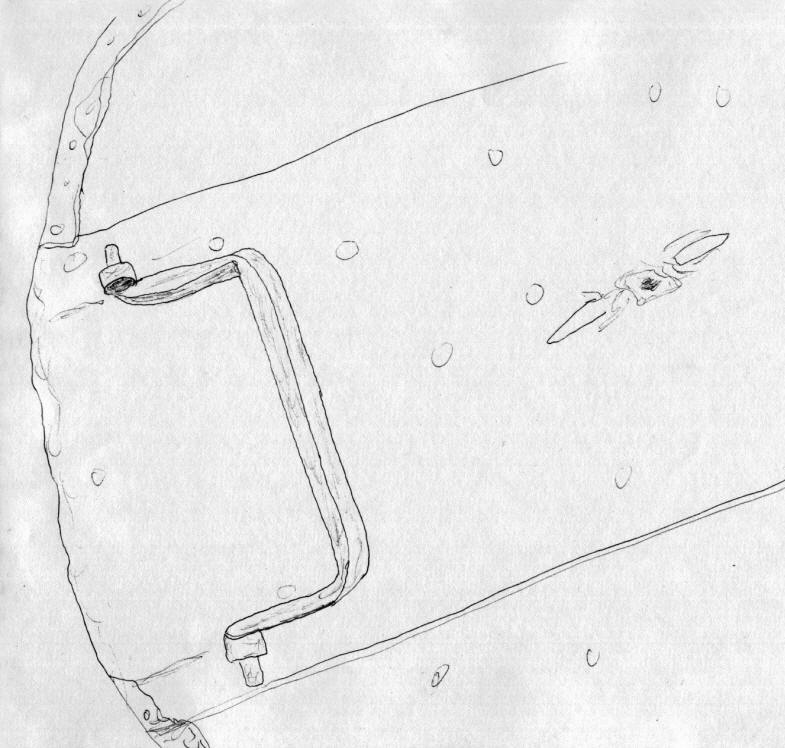
'Gott Bewahr Die Oprechte Schotten'
XX ANDRIA XX FARARA XX
Mac's PictureTrail
|
|
   |
 |
Joe Lindsay
Industry Professional

Location: Scotland Joined: 07 Nov 2006
Posts: 8
|
 Posted: Sat 30 Dec, 2006 3:18 pm Post subject: Posted: Sat 30 Dec, 2006 3:18 pm Post subject: |
 |
|
OOPS sorry, I'm still not used to this forum thing.
Joe Lindsay
Forum learner (I'll get there, I'll get there )
www.targemaker.co.uk
 Attachment: 41.43 KB Attachment: 41.43 KB
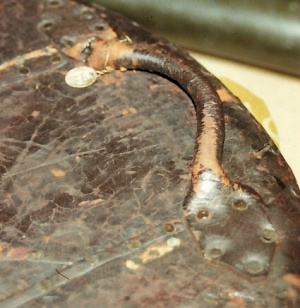
 Attachment: 46.82 KB Attachment: 46.82 KB
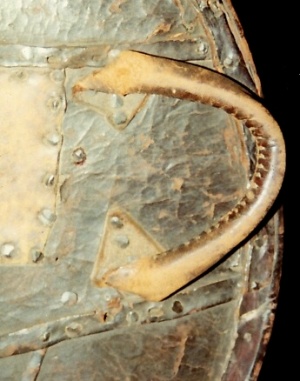
 Attachment: 30.7 KB Attachment: 30.7 KB
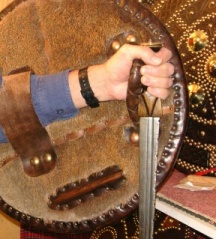
Nothing is ever what it seems - old john
|
|
   |
 |
|
GG Osborne
|
 Posted: Sat 30 Dec, 2006 7:11 pm Post subject: David Morier as a reference Posted: Sat 30 Dec, 2006 7:11 pm Post subject: David Morier as a reference |
 |
|
This may just be stating the obivious, Joe, but the famous Morier Culloden scene had to be painted years after the battle. I would conservately estimate no earlier than 6 years and probably 10. I base this on the uniforms illustrated for Barrell's Regiment. In 1746, Barrell's Regt. was not a "Royal" regiment, yet the Grenadiers in the painting are wearing the cap badges depicting their status as one of the "Old Regiments" specifically permitted to wear their special cap badges on the grenadier miter cap rather than the standard Hanovarian red field and "GR." This had to be after Culloden by a long shot as this uniform stipulation was't in effect until well into the decade of the 1750s.
In 1752, Morier was retained by our old nemisis "Stinki'n Billie" (otherwise known to history as William, Duke of Cumberland) to paint an accurate depiction of the uniform of every line regiment in the Englist infantry establishment at that time. I happen to have a copy of that "Clothing Book" illustrating the uniforms. Ireland had it's own military establishment. The subject chosen was a private of the Grenadier Company from each regiment , with the exception of the 41st or Invalid's Regiment, a group of old soldiers usually placed there in semi-retirement. The pictures show the Clothing Warrant of the 1750s which was ordered well after Culloden and the Rebellion of 1745-46. In short Barrell's Regiment in 1746 would have been uniformed completely differently than the unifrom illustrated in the celebrated Morier picture. The mitre cap devices, the cuffs on the coat, the lace patterns, and the marching gaiters are dead give-aways to a 1752 or later date.
My personal guess is that the "Scottish subjects" were British soldiers who were handed relics of the battle and told to pose as they assumed wild Scots would look. I base that assumption on the way the actual weapons are being handled and the poisition of the targaids among other things. Authentic pictures and sketches from the period show targaids held high for the parrying of a blow at the head or turning a bayonet thrust aside. The British Manual of Arms from the period states that the bayonet to be held rather high, slung over the crook of the left arm, the body slightly turned to the right and the right hand firmly against the butt of the musket for leverahe in a thrust, or else at shoulder height. The position of the soldiers in Morier's "Incident" painting are more reiminiscent of the 1768 Manual. Also, reports of British casualties at Prestonpans describe classic slashing wounds that would have come from on overhand blow, not a thrust. Common sense dictates that if a chap is facing you with a Long Land Pattern musket with an additiona 12-14" of steel at the business end, your first order of business is to parry the bayonet and slash at the unprotected head and shoulders, not to get fancy with duelling poses and level trust.
With regards to the Locaber axe and the dirks, I believe these are just props being handled by well-meaning amateurs who had no idea of what they wre doing since they had not used said weapons in combat. (A luckless guide, indeed, Joe Lindsey!) Remember, who was this picture painted for in the first place? Hint: it is owned by the Queen! A nice piece of propaganda, indeed!!
I know I am a complete "Penicuick Sketch" freak, but as nice and romantic as Morier's picture is...it is just that, a nice and romantic dipiction of what respectable London thought the wild Scots at Culloden should have looked like. About as reliable as a Roy Rodgers or Gene Autry coyboy flick for depicting Apaches or Cheyenne indians, I surmise.
Finally, if my dating is right based on the cut of the uniforms, all of the Culloden prisioners had been dealt with by that time, there just wouldn't have been any prisioners available to pose. So, nice picture, David, but not a reliable guide for Culloden!
"Those who live by the sword...will usually die with a huge, unpaid credit card balance!"
|
|
  |
 |
Thomas McDonald
myArmoury Alumni


|
 Posted: Sun 31 Dec, 2006 6:49 am Post subject: Posted: Sun 31 Dec, 2006 6:49 am Post subject: |
 |
|
The Highland attack on the Grenadier Company of Barrell's King's Own Royal Regiment, by David Morier.
Mac
 Attachment: 113.06 KB Attachment: 113.06 KB
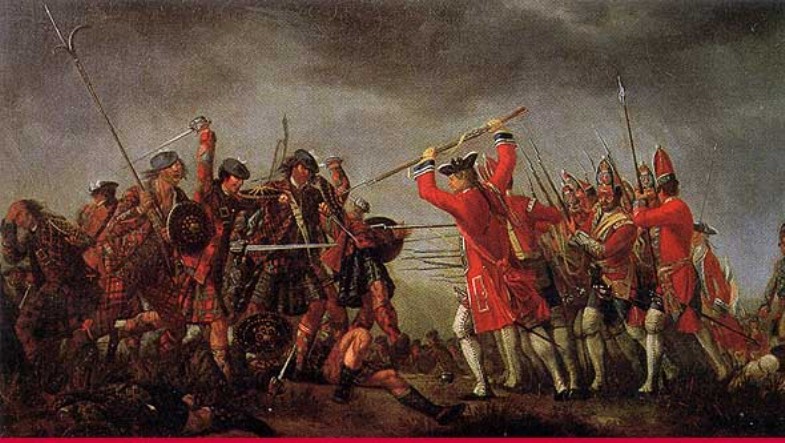
'Gott Bewahr Die Oprechte Schotten'
XX ANDRIA XX FARARA XX
Mac's PictureTrail
|
|
   |
 |
|
|
You cannot post new topics in this forum
You cannot reply to topics in this forum
You cannot edit your posts in this forum
You cannot delete your posts in this forum
You cannot vote in polls in this forum
You cannot attach files in this forum
You can download files in this forum
|
All contents © Copyright 2003-2024 myArmoury.com — All rights reserved
Discussion forums powered by phpBB © The phpBB Group
Switch to the Basic Low-bandwidth Version of the forum
|

